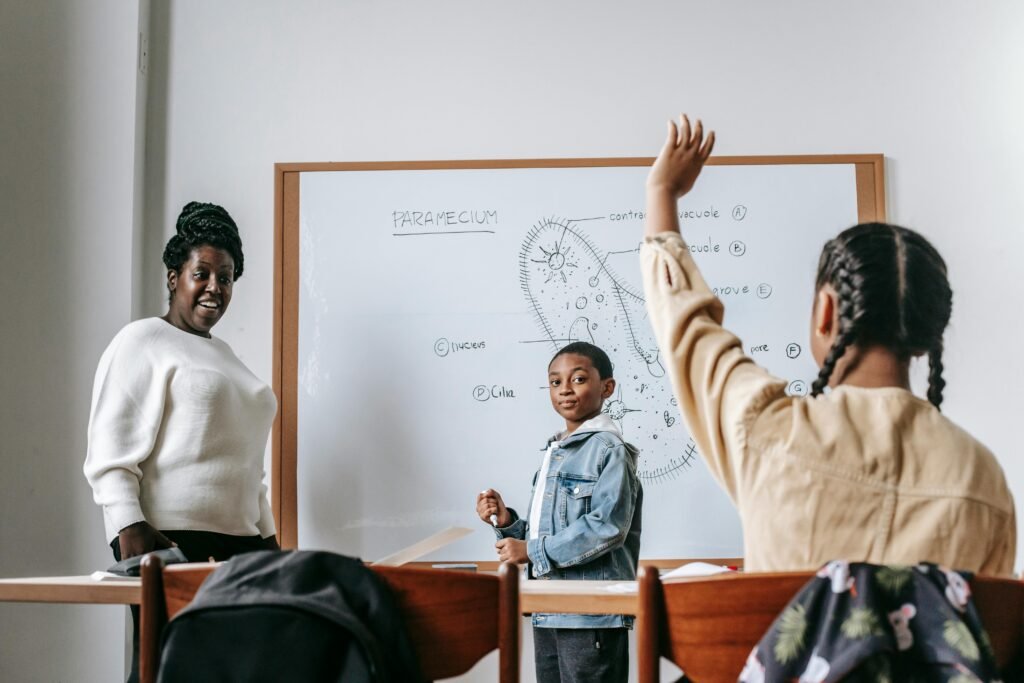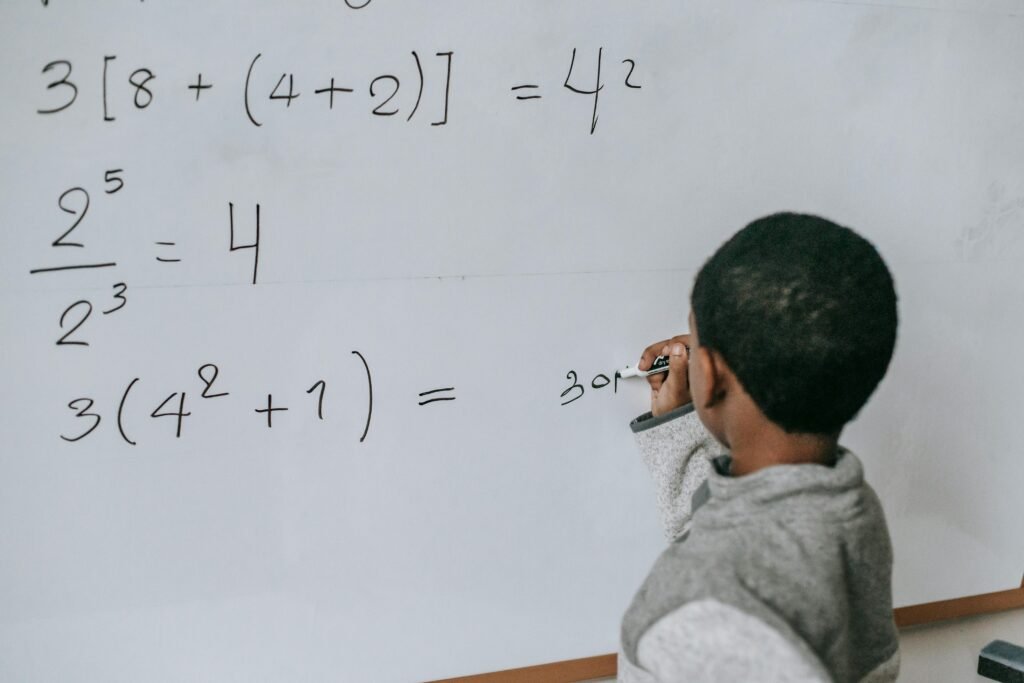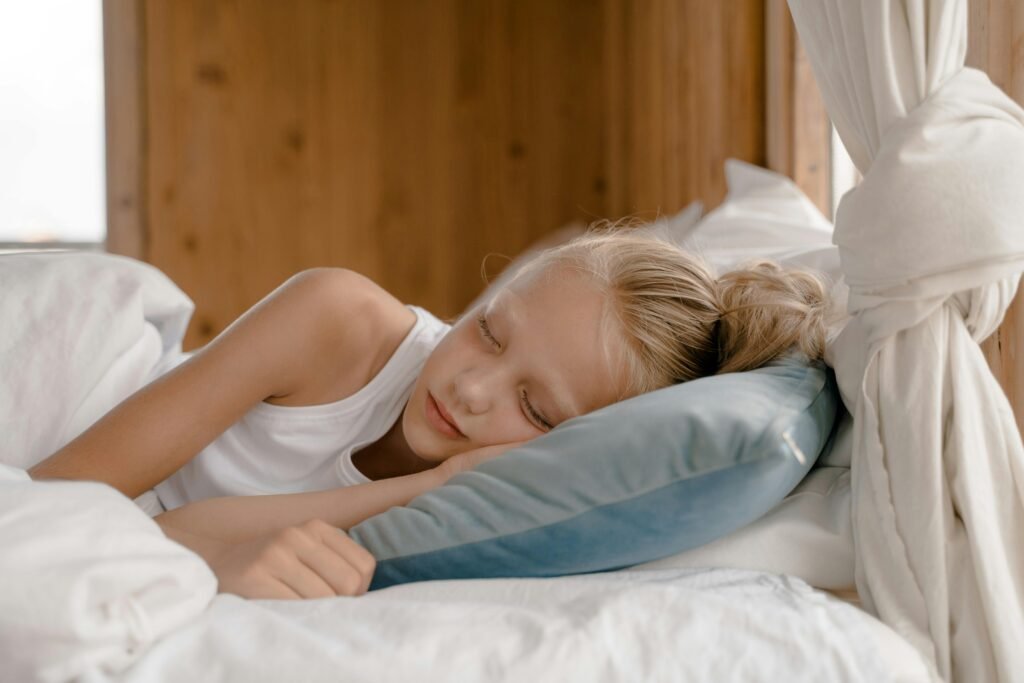Screens are everywhere. From morning till bedtime, most kids are using tablets, phones, or computers. Whether it’s for learning, fun, or just passing time, screen time is going up. But here’s the thing: too much screen time can quietly hurt your child’s grades, sleep, and even confidence.
Students who reduced screen time by 50% during detox weeks saw a 20% improvement in test scores
This stat is powerful. Just by cutting screen time in half for one week, students saw a 20% jump in test scores. That’s the difference between a C and a B+, or even a B and an A.
Why does this happen? It’s simple. Less screen time means more attention left over for studying. The brain gets more rest. The eyes are less tired. And the child is less distracted. Screens, especially social media and video games, overload the brain. They reduce memory strength and make it harder to focus on important things like reading or math.
When screens are reduced, the brain gets a break. It can absorb information better and hold onto it longer. That’s why even one week of screen reduction can lift test performance so quickly.
Here’s what you can do right now. Start small. Pick one week this month to try a digital detox. Tell your child it’s just for 7 days. During that time, reduce their total daily screen time by half. If they usually have 4 hours of screen use, aim for 2. If they have 6 hours, aim for 3.
Replace that time with quiet study, reading, outdoor play, or a creative hobby like drawing or building. You don’t need to completely cut out all screens—just cut them down. Keep screens for schoolwork only.
Make sure your child understands this is not a punishment. It’s a reset. Remind them it’s temporary and it will help them think sharper. Make it a fun challenge. Even better, do it as a family.
Watch what happens by the end of the week. You might just see your child sit down to study without a reminder. You might hear them say, “I remember that!” when reviewing for a test. That’s the magic of less screen time.
82% of teens report better sleep quality after a digital detox week
Sleep is like a superpower for kids. But screens before bed? They steal that power. Blue light from phones and tablets tricks the brain into staying awake. It slows melatonin, the sleep hormone, and keeps kids wired even when they feel tired.
That’s why this stat matters. After just one week without screens before bed, 82% of teens slept better. Not just longer—better. Deeper. More restful. And the effects showed up fast.
When kids sleep well, their brains work better the next day. They remember more. They can focus longer. And they’re less cranky. This leads to better grades and better moods.
So what can you do to help? Start by creating a simple bedtime rule—no screens at least one hour before bed. That one rule can change everything. Replace screen time with quiet reading, journaling, or just talking together. Keep the bedroom screen-free, if possible. Move phones to the kitchen or living room to charge overnight.
Be consistent. Kids may resist at first, but after a few nights of better sleep, they’ll notice the change. You might hear, “I actually feel awake this morning,” or “I didn’t wake up at all last night.” That’s your sign it’s working.
If your child struggles to fall asleep, use this detox week to build a strong bedtime routine. Warm bath, low lights, soft music, and reading can all help. Try to keep the same sleep time and wake-up time every day—even on weekends.
Better sleep doesn’t just help with grades. It helps with mood, patience, and energy too. And all of it starts with cutting back on screens before bed.
64% of students experienced less stress after reducing screen time for one week
Kids today are under more pressure than ever. Tests, grades, friendships, and expectations—it can all feel like too much. And here’s what’s surprising: screens add to that stress.
Social media, endless messages, and even too much homework on screens keep their brains running non-stop. That’s why when students reduce screen time for just a week, 64% say they feel less stress.
When screens are off, kids aren’t comparing themselves to others. They aren’t chasing likes or trying to keep up with online trends. They breathe more. They think more clearly. They feel calmer.
Here’s how to help your child feel this too. During your detox week, create more quiet time. Let them rest without background noise. Encourage journaling or sketching. Take short walks. Do puzzles together. These slow, screen-free activities lower cortisol, the stress hormone.
You can also teach your child to notice how they feel after being on screens for a long time. Are they more tired? Irritable? Distracted? Then ask them to compare that to how they feel after reading a book or going outside.
Let your child lead some of the detox too. Ask them how they want to relax without screens. Give them choices, not just rules. The more they feel in control, the less stress they’ll feel.
A calm mind is a learning mind. Less stress helps kids listen better, remember more, and enjoy school again.
Children aged 8–14 who took screen breaks improved focus by 32%
Focus is like a flashlight. The more you move it around, the less it lights up. That’s what screens do to your child’s focus—they keep moving the light.
But when screens are paused, that flashlight gets steady. That’s why kids between 8 and 14 saw a 32% boost in focus just by taking screen breaks.
Here’s the thing: the brain is like a muscle. If it’s pulled in too many directions—messages, videos, games—it gets tired. But when the brain has fewer distractions, it can lock in. That’s when real learning happens.
To build your child’s focus, try the “25-5” rule during detox week. That means 25 minutes of no-screen study time, followed by a 5-minute break. Set a timer. During breaks, stretch, walk, or grab a snack. Then repeat.

Also, remove background screens during study time. No TV in the room. No music videos playing. Let the study space be quiet and clean.
If your child needs help getting started, use a checklist. Write down 2 or 3 tasks at a time. Let them cross off each one. It keeps the brain organized and gives a little win every time.
After a few days, you’ll notice your child getting into “study mode” faster. They won’t reach for their phone as much. They’ll sit longer without fidgeting. That’s focus getting stronger.
70% of parents reported improved behavior in kids after a digital detox
When screens go away, good behavior often comes back. That’s what many parents see. In fact, 70% of parents say their child acted better after a week of less screen time.
Why? Because too much screen use can lead to quick frustration, short tempers, and ignoring instructions. When kids are glued to screens, they tune out the world around them—including their parents. They’re more likely to snap back, whine, or resist simple requests.
But during a digital detox, the noise quiets down. Kids start to reconnect. They listen more. They talk more. They stop rushing and start noticing. That small shift changes everything about how they behave at home and school.
If you want to see this change, set clear expectations at the start of detox week. Let your child know that you’re all trying this together, and it’s not a punishment. Replace screen time with shared activities—board games, baking, chores, or crafts. These slow, real-world tasks give kids something screens can’t—connection and calm.
Don’t expect perfect behavior right away. There might be pushback at first, especially if your child is used to lots of screen time. Stay calm and be patient. Offer praise when they cooperate or help around the house.
You’ll start to see a softer tone, better listening, and more helpfulness. These small changes in behavior often stick long after detox week is over.
One week of reduced screen use led to a 25% increase in daily reading time
This is a game-changer. Just by cutting screen time, kids started reading 25% more each day. That’s not by accident. When screens take a back seat, books move forward.
Reading builds everything—vocabulary, imagination, memory, and even emotional smarts. It’s also one of the best habits for academic growth. But when screens are always available, reading loses the race.
That’s why detox weeks are the perfect time to rebuild a love for books. Start by creating a reading corner in your home. Keep it cozy and quiet, with pillows and a small shelf of books your child picks. Let them choose what they want to read—even comics or joke books. The key is to make reading feel fun, not forced.
During detox week, replace 30 minutes of screen time with reading. Make it part of the routine—after dinner, before bed, or first thing in the morning. Read together if your child is younger. Take turns or talk about the story afterward.
If your child resists, don’t give up. Sometimes it takes a few tries to find the right book. Visit the library and let them explore different genres—mystery, fantasy, science, or sports. Reading isn’t just about school—it’s about curiosity and stories.
You might be surprised when your child starts asking, “Can I read for a bit?” That’s the moment you know the detox is working.
Students on a digital detox were 40% more likely to finish homework on time
Homework can be a daily struggle in many homes. Kids are tired, distracted, or just not motivated. But one simple change can fix it: less screen time. When students went on a digital detox, they were 40% more likely to finish homework on time.
This makes sense. Screens eat up attention. Games, videos, and chatting pull kids away from tasks. But when those distractions are reduced, homework feels more doable. It gets done faster—and with fewer arguments.
To make this work, start with a clear homework window during detox week. Choose a consistent time every day—right after snack, or before dinner. Let your child know that screens will be off during this time. No quick games. No background shows. Just calm, focused time.
Create a study-friendly spot that’s quiet and well-lit. Keep only the supplies they need—pencils, paper, calculator. If they use a device for homework, use apps or settings that block other sites while they work.
Stay close during homework time but avoid hovering. Be there to help if needed, but let your child do the thinking. Praise them when they stick to it and finish without reminders.
Over time, they’ll build a new habit—starting and finishing without stalling. That habit will stick even after the detox week is over.
68% of kids said they felt “happier” after a no-screen week
This stat says it all. After just one week without games, social media, or endless YouTube, nearly 7 out of 10 kids said they felt happier. That’s huge.
Screens might entertain kids, but they don’t always make them feel good. In fact, the more time kids spend online, the more likely they are to feel left out, bored, or even anxious. Social media especially can bring comparison, pressure, and stress.
But when the screens go away, something beautiful happens. Kids remember how to be kids again. They laugh more. They talk more. They feel lighter.
If you want to bring more joy into your child’s week, a digital detox is one of the best gifts you can give. Fill that time with small moments that matter—nature walks, baking cookies, building with blocks, or just lying on the grass and talking.
Let your child lead. Ask them, “What would be fun to do without screens this week?” You might be surprised by their answers. Some may want to ride bikes, try art, or play dress-up. Follow their interests.
Keep a journal or take notes during the week. Write down the smiles, the silly things they say, the quiet moments you share. These are reminders that happiness doesn’t live in a device—it lives in the moments we make.
Average grades rose by 12% for students who did regular digital detox weeks
Imagine your child’s average grade jumping up by 12%—just from doing a digital detox regularly. That’s a solid improvement across subjects like math, science, reading, and more. And it doesn’t take a fancy tutor or long hours. It just takes a simple habit: cutting screen time for one week each month.
Why does this work? Because detox weeks reset the brain. They help kids build focus, reduce stress, sleep better, and take in information more deeply. When screens are off, learning becomes the main focus. The mind becomes clear. And effort increases naturally.
To make this work in your family, try making the digital detox a routine. Choose one week every month where you pause or limit all non-school screen use. Tell your child in advance so they can prepare.
Use that time to review school lessons, do quiet practice, or read together. You don’t need to add pressure—just make it a calm, screen-light week where school comes first. Let your child track their grades or test results afterward. Seeing real progress makes them proud and more willing to keep going.
This isn’t about being perfect. Even cutting back part of the screen time makes a difference. A regular detox builds the muscle of learning, and every time you do it, that muscle grows stronger.
Attention span increased by 30% after one week without games and social media
A long attention span is like gold for learning. It helps kids listen longer, read deeper, and finish big tasks. But games and social media work against that. They train the brain to switch quickly from one thing to the next, making focus harder.
That’s why this stat is so big—30% more attention in just a week without those distractions.
You might see it in small ways. Your child might read a full chapter without looking up. They might finish math problems without needing a break. They might stay in the conversation longer at the dinner table. That’s the brain adjusting back to slower, more focused thinking.
To build this during detox week, cut out all social media and games completely. Keep the rule simple: “No gaming or scrolling this week. Let’s try other things.”
Use this time to practice “deep play.” That’s play that takes longer—like building a Lego city, painting a full picture, or doing a big puzzle. These activities stretch attention gently and naturally.
You can also build focus through guided reading time or longer learning projects. If your child enjoys science, try an experiment. If they love stories, write a short one together.
Attention span is like a balloon. It stretches more each time you use it fully. A week without fast-swiping screens gives that balloon the space to grow.
55% of students reported feeling more “mentally sharp” after screen breaks
Kids know how their brains feel. And over half of them—55%—said they felt “mentally sharp” after taking a break from screens. That means clearer thinking, better problem-solving, and quicker answers in class.
Screens overload the senses. The fast pace, bright colors, constant notifications—these things tire the brain without us even realizing. But when screens are paused, the brain gets a chance to reset. It starts working smarter, not harder.
To help your child feel this mental clarity, keep the detox week full of calm focus time. Not just schoolwork—but also open-ended tasks that build thinking skills. Let them plan a small event, solve a tricky puzzle, or help cook using measurements. These real-world tasks engage the brain in ways screens can’t.
Also, encourage quiet thinking time. Not every moment needs to be filled. Give your child space to sit and think or just rest. Mental sharpness often comes in the quiet—when there’s room for thoughts to form.
Your child might say things like, “I can think better today,” or “I figured that out faster.” That’s the detox at work. It’s not magic—it’s just giving the brain room to breathe and build strength.
Family conversations increased by 65% during digital detox weeks
Screens don’t just take up space—they take up moments. Family time often gets squeezed out by silent scrolling or solo gaming. But here’s the good news: during digital detox weeks, family conversations went up by 65%.
That means more stories, more laughs, and more connection. And those moments matter more than anything else.
During detox week, use meals as a time to talk. No phones at the table. No screens in the background. Just you and your child, sharing about your day. Ask open-ended questions like, “What made you smile today?” or “What was tricky at school?”

You can also do simple activities that spark conversation—walks, cooking, building something together. These shared tasks naturally lead to talking and bonding.
If your child isn’t a big talker, that’s okay. Don’t push. Just be present. The more you show up, the more they’ll start opening up. Over time, this trust builds, and conversations become more natural.
These family talks strengthen emotional health. They build vocabulary. They teach listening and kindness. And they remind your child they’re seen and valued.
78% of students felt “more in control” of their time after a digital detox
Time feels slippery when screens are in charge. One minute your child is checking a message, and suddenly an hour has flown by. That feeling of losing time can make kids feel rushed, scattered, or even anxious.
But after a digital detox week, 78% of students said they felt more in control of their time. That’s because without constant screen distractions, kids get to own their schedule again.
You’ll likely see it too. Kids who aren’t always bouncing between videos and games start to notice time more. They think, “I have 30 minutes—what should I do with it?” Instead of being pulled by the screen, they learn to plan, pace, and use time wisely.
To help your child feel this control, create a simple daily routine during detox week. You don’t need a packed schedule. Just a few blocks of time—for reading, schoolwork, creative play, and rest. Let your child help design it. When they have a say, they care more.
Use timers to gently manage screen-free study blocks. Let your child check off what they complete each day. That simple habit gives them a sense of power. They’re not just reacting—they’re choosing.
By the end of the week, you may hear them say, “I like knowing what I’m doing next,” or “That went by fast, but I got so much done.” That’s time control—and it builds confidence and calm.
3 in 4 students said they had more fun doing offline activities during detox week
Here’s a happy surprise—3 in 4 students said they had more fun during detox week. More fun, even without their favorite apps or games.
That’s because screens are only one kind of fun. Real-world fun—the kind that uses hands, imagination, and movement—feels richer and lasts longer.
During detox week, try new activities your child might enjoy. Build a pillow fort. Bake a new recipe. Make paper airplanes and have contests. Plant seeds in cups and watch them grow. Even chores can become fun when done together with a little music and laughter.
Let your child lead with ideas. Ask them, “What would you love to try this week—no screens allowed?” You might be surprised by what they pick. Kids are naturally creative when given the space.
Also, keep a “fun jar.” Write down ideas and pull one out when boredom hits. This keeps the week fresh and gives your child something to look forward to each day.
By the end of the week, your child may not want to go back to the screen as quickly. They’ll remember that fun doesn’t live in apps—it lives in moments.
47% of students discovered a new offline hobby during a detox week
Almost half of all students—47%—found a new hobby during their detox. That’s amazing. It means one week without screens didn’t just pass the time—it opened a door.
Hobbies build skill, joy, and identity. They teach kids how to stick with something, how to learn by doing, and how to enjoy their own company. Whether it’s drawing, skateboarding, knitting, or chess, a hobby adds richness to life.
During your detox week, give your child time to explore. Provide a few materials if you can—art supplies, puzzles, a ball, or old tools. Go to the library or craft store for ideas. Or just let them dig through a closet and invent something with what’s around.
Watch what your child returns to again and again. That’s often the start of a new hobby.
Be supportive, not perfect. If your child tries something and doesn’t like it, that’s okay. Trying is the win. The more they explore, the more likely they’ll find something that lights them up.
And once they do, let them own it. Give them space to enjoy it at their pace. That hobby might become a lifelong love—or even a future career.
80% of parents noticed improved eye health in children during no-screen weeks
Eye strain is real. Kids who spend hours staring at screens often deal with dry eyes, headaches, or blurred vision. But during digital detox weeks, 80% of parents noticed a clear improvement in their child’s eye comfort and health.
It makes sense. Screens require constant focus at a close distance. That tires the tiny muscles around the eyes. When screens are removed, those muscles finally get to rest.
To protect your child’s vision during and after detox week, try the 20-20-20 rule. Every 20 minutes of screen time, look at something 20 feet away for 20 seconds. Even after detox week is over, this helps.
Also, encourage more outdoor play. Natural light is great for eye development, and looking far away helps balance near work.
During detox week, reduce all unnecessary screen time—even for school. If your child needs to do lessons online, let them sit near a window or take stretch breaks often. Use books and paper activities when possible.
You may see your child squint less or complain less about tired eyes. That’s real progress. And it shows that one small change—less screen time—can lead to healthier, happier eyes.
Kids who did digital detoxes slept 90 minutes more per night on average
Sleep is like food for the brain—and most kids aren’t getting enough of it. But when screens are paused for just one week, children sleep an average of 90 minutes more each night. That’s huge.
This extra sleep comes from two things. First, screens before bed delay melatonin, the sleep hormone. Without them, the body winds down naturally. Second, with less screen time, kids feel more balanced and relaxed—making it easier to fall asleep.
To build this into your detox week, set a clear “tech curfew.” For example, all screens off by 7:30 p.m. Try dimming the lights, lowering noise, and helping your child move into bedtime gently.

Create a screen-free bedtime routine your child enjoys. It could be a warm shower, reading together, a calming playlist, or even a simple conversation in bed. Try to make bedtime the coziest, calmest part of the day.
If your child resists at first, keep going. After two or three nights, their body will adjust, and you’ll likely see big improvements. They’ll wake up earlier, feel more rested, and start the day with energy—not grumpiness.
Extra sleep also boosts memory, focus, mood, and immune strength. It’s one of the easiest and most powerful changes you can give your child.
6 in 10 students said they felt more confident speaking in class after a detox
Confidence is quiet but powerful. And after a screen-free week, 6 in 10 students said they felt more confident speaking up in class. That’s because digital detox weeks don’t just change habits—they change how kids feel about themselves.
Without screens doing all the talking, kids start to use their own voice more. They make eye contact. They listen better. They get comfortable with silence—and with jumping in to speak.
To support this during detox week, create moments for real conversation. Ask your child about what they’re learning at school. Practice role-playing questions a teacher might ask. Talk about opinions and ideas. Let them explain a concept they’ve learned to you.
You can also boost confidence by encouraging open-ended play and storytelling. Let them invent a story or teach you how to do something. These simple tasks give them practice with words—and that spills over into school.
Remember, confidence builds with practice and praise. So when your child speaks up, show them that you’re proud. Help them notice their own progress. The more they feel heard at home, the more they’ll speak up at school.
Students spent 2x more time studying when not distracted by screens
Imagine your child studying twice as long—without being asked. That’s what happens when screens are reduced. Without the constant ping of messages or the pull of quick entertainment, kids naturally spend 2x more time studying.
It’s not just about time—it’s about quality. When there’s no phone buzzing nearby, the brain can fully dive into learning. Kids get into flow. They stick with hard problems. They finish their work with fewer breaks.
During detox week, set a daily study window that is screen-free unless needed for school. Use a timer, like 30 minutes on, then 10 minutes off. Keep distractions away—no background shows or half-open tabs.
Also, ask your child how they feel after study time. Are they proud? Calm? Less frustrated? Help them connect the dots between screen-free focus and real progress.
If possible, study together. While your child works, you can read or do a quiet task nearby. This models good habits and gives them support without pressure.
By the end of the week, you may notice them sitting down to study without reminders. That’s the sign of growing independence and stronger learning habits.
71% of teens felt less anxious after reducing screen time for 7 days
Teen anxiety is rising—and screens are a big part of the problem. Constant messages, news, social media comparisons, and online pressure create a mental storm that doesn’t go away. But just 7 days of reduced screen time helped 71% of teens feel less anxious.
That’s a life-changing shift. Less anxiety means better focus, better relationships, and more peace.
To make this part of your detox week, have open talks about feelings. Ask your child how they feel after scrolling. Are they more stressed or calm? Then help them replace that habit with one that relaxes their mind—like journaling, going for a walk, or listening to calming music.
Encourage slow, quiet moments. Anxiety often hides under busyness. Let your child know that it’s okay to rest. Give them time with no expectations—just peace.
Also, help them notice the mental difference as the week goes on. Do they feel clearer? Sleep better? Feel more in control? These insights help the change stick.
Anxiety won’t vanish in one week, but a detox gives your child the tools to cope better. And knowing that they can help reduce their own stress builds strength for life.
Homework completion rates improved by 45% during screen-free weeks
Homework doesn’t have to be a daily battle. When screens are out of the picture, kids are far more likely to just sit down and get it done. In fact, during detox weeks, homework completion rates improved by 45%.
Why? Because without constant alerts and distractions, kids can start, focus, and finish their homework more easily. The task stops feeling overwhelming and starts to feel manageable—even doable.
During your detox week, create a clear “homework time” that happens at the same time every day. This routine helps your child know what to expect. For example, homework might happen from 4:30 p.m. to 5:30 p.m. each day, no screens allowed during that hour unless they’re needed for the assignment.

Make homework time peaceful. Remove all extra devices. Provide a clean space with good lighting and everything your child needs—pencils, erasers, scratch paper, or textbooks. Sit nearby to offer quiet support, but don’t hover.
You can also use a simple checklist for each assignment. Help your child break work into smaller steps and cross off each one as they go. That little win with every checkmark helps build momentum.
By the end of the week, your child might surprise you by saying, “I’m already done,” or “I don’t mind homework as much anymore.” When screens stop pulling them away, learning starts pulling them forward.
Students were 50% more likely to meet fitness goals during detox weeks
Screens keep kids sitting. But during digital detox weeks, students were 50% more likely to hit their fitness goals—whether that’s steps walked, minutes played outside, or time spent being active.
This happens because when screens go down, movement goes up. Kids naturally begin to explore, run, jump, and play. They don’t need a fancy gym or program—they just need space, time, and encouragement.
To make this real during your detox week, plan one physical activity per day. It could be a walk, a bike ride, jumping rope, kicking a ball, or dancing in the living room. Let your child choose what sounds fun.
Set a fun challenge like, “Let’s see if we can be active for 30 minutes every day this week.” Track progress on a calendar or a simple goal chart. Celebrate with a high five or a reward like choosing dinner on Friday.
If your child enjoys competition, turn it into a game. See who can do more jumping jacks. Race to the end of the driveway and back. Kids love to move—they just need the space to remember how good it feels.
And as your child moves more, you’ll also see changes in their mood, sleep, and energy. All of it feeds into better learning and a stronger, happier body.
9 out of 10 kids said they want to do digital detox again after trying it once
You might think kids would hate a screen-free week—but surprisingly, 9 out of 10 kids who tried it once wanted to do it again. That tells you something important: kids like how they feel when they unplug.
They may not say it at the start. There might be grumbles or pushback. But by the end of the week, kids often feel clearer, lighter, and more connected to the world around them. They enjoy the new hobbies, the conversations, the sense of time and calm.
To help this happen, make your first detox week a shared challenge. Do it as a family. Be open about why you’re doing it—“to feel better, sleep better, and have more fun together.”
Keep the tone positive. Instead of saying “No screens,” try saying “Let’s try some screen-free adventures this week.” Frame it as a game, not a punishment.
At the end of the week, talk about what worked. What did your child enjoy most? What surprised them? What would they change next time? Let them be part of planning the next detox.
Kids love to feel ownership. And once they’ve experienced a detox once, they often ask for another one. That’s when you know you’ve started a habit that could last a lifetime.
Emotional regulation improved in 63% of kids after one screen-free week
Screens can stir up strong feelings fast. Excitement, frustration, anger, jealousy—it all happens quickly and often all at once. But during detox weeks, 63% of kids showed better emotional control. They didn’t snap as quickly. They handled stress better. They felt more even.
This is huge because emotional regulation is the root of so many life skills—handling disappointment, working through a tough problem, staying calm when things go wrong.
During detox week, give your child words to name their feelings. If they seem frustrated or sad, ask gently, “How are you feeling right now?” or “What’s going on in your mind?”
Also, give them simple calming tools they can use when big feelings rise—deep breathing, taking a walk, hugging a pillow, or just sitting quietly for a moment.
If your child is younger, use drawing or storytelling to explore emotions. Let them show what they’re feeling with pictures or dolls. For older kids, journaling or quiet talks help release tension in a safe way.
Watch how your child begins to respond differently. They might take a breath before yelling. They might ask for space instead of storming off. These tiny wins are the roots of strong emotional health—and it all starts with giving the brain a little more quiet each day.
Kids spent 3x more time playing outdoors during digital detox weeks
Outdoor play is magic. It builds muscles, sparks imagination, reduces stress, and brings out laughter. But screens steal that time. When kids are glued to devices, they’re not running, climbing, exploring, or creating. That’s why it’s so powerful that during detox weeks, kids spent 3 times more time outdoors.
Nature calms the brain and fills the senses. The sunlight, wind, and space help reset moods and improve thinking. Plus, outdoor play builds physical strength, coordination, and even social skills if they’re playing with siblings or friends.
To make the most of this during your detox week, open the door—literally. Invite your child to go outside every day, even if it’s just the backyard or sidewalk. If possible, go with them. Take a short walk together, bring a ball, or sit in the park.
Let your child lead the way. Don’t worry about planning the perfect activity. Often, once they’re outside, kids naturally find ways to stay busy. They might build with sticks, chase birds, collect rocks, or make up a new game.

If weather is tricky, dress for it. Even a rainy day can be fun with boots and a coat. If it’s very hot or cold, aim for early mornings or late afternoons.
The goal is simple: let nature take over. Let play be free. Let curiosity bloom. And most of all, make outdoor time a habit that continues well beyond the detox week.
Academic confidence improved by 36% in students who reduced screen time
Confidence can turn an average student into a great one. It’s not just about knowing the answer—it’s about believing they can figure things out. During digital detox weeks, academic confidence rose by 36%. That’s a big jump in just seven days.
When screens go down, kids often surprise themselves. They realize, “I can solve this math problem,” or “I actually remember what I read.” Without the constant comparison or distractions, they start seeing their own progress. That builds real self-trust.
To support this growth during your detox week, give your child time to reflect. At the end of each study session, ask, “What’s one thing you’re proud of today?” or “What was easier than you thought it would be?”
Let them keep a small “confidence journal” where they write down one success per day—even small ones like finishing a paragraph or spelling a hard word right. These daily wins stack up and show them they’re capable.
Also, praise effort, not just results. Say things like, “I saw how focused you were today,” or “You really stuck with that problem.” Effort leads to learning—and learning leads to confidence.
When a child starts saying, “I can do this,” they’re not just improving grades—they’re building a mindset that will help them for life.
66% of students said they felt “less rushed” during their detox week
Modern life moves fast. And kids feel that pressure too. Between school, homework, screen time, and activities, there’s barely a moment to breathe. But during digital detox weeks, 66% of students said they felt less rushed.
This feeling is powerful. When kids aren’t bouncing between screens and school, they feel time slow down. They can think more clearly, finish tasks fully, and enjoy their day more deeply.
To create this space during detox week, avoid overscheduling. Don’t try to fill every hour. Instead, build in calm periods where your child can move at their own pace.
Try having one “slow morning” or “slow evening” during the week. No rushing, no tasks—just time to eat, talk, and enjoy being together. Let your child help set the rhythm for those times.
Also, remove the background stressors—no TV news, no urgent notifications. Play soft music or just enjoy the quiet.
Ask your child how they feel in those slower moments. Are they calmer? Do they like having time to think or explore? This helps them understand the value of stillness and rest.
In the long run, kids who feel less rushed learn better and enjoy life more. And that simple shift begins when you take away the screen rush and replace it with rhythm.
Screen-free students were 2x more likely to participate in class
Participation matters. When kids speak up in class, they learn faster and build confidence. But many stay quiet—not because they don’t know, but because they’re distracted or disconnected. During digital detox weeks, students were twice as likely to participate in class.
Why? Because without screens draining their focus, kids have more mental energy. They’re more alert, more prepared, and more confident. They remember what they learned. They hear what the teacher is asking. And they’re ready to respond.
To support this, talk with your child about their school day during the detox week. Ask, “Did you raise your hand today?” or “What did you say during class?” Make it a normal part of conversation.
Also, encourage active listening at home. During story time, ask questions. When watching a documentary together, pause and discuss. These small habits teach your child to think while listening—and to respond with ideas.
If your child is shy, remind them that participation doesn’t always mean speaking aloud. It can be helping a friend, turning in work on time, or writing a thoughtful answer. Any form of engagement counts.
Over time, your child will start raising their hand more, asking questions, and even helping others understand the material. That’s not just participation—it’s leadership.
59% of students saw improvement in memory and retention after detoxing
Memory is the brain’s filing system. When it works well, learning sticks. Kids remember what they read, what the teacher said, and how to solve problems. But when the brain is overloaded with screen input, it gets harder to store and recall information.
That’s why digital detox weeks make such a big difference. In just seven days, 59% of students noticed they could remember things better.
This happens because screen time—especially fast-moving content like games, short videos, and social media—can overload the brain’s short-term memory. But with less screen noise, the brain gets space to focus, organize, and store new knowledge.
During detox week, you can boost your child’s memory even more with a few simple activities. After reading a book, ask them to retell the story in their own words. After a math session, ask, “How did you solve that one?” These moments strengthen memory through reflection.
Another trick is using mini-reviews. Go over school material for 5 minutes at the end of the day. Not a full study session—just a quick, gentle recap. This helps transfer short-term learning into long-term memory.
Also, let your child sleep well, eat brain-boosting snacks (like fruits, nuts, or yogurt), and get regular movement. These habits make the brain stronger and more efficient.
When your child starts remembering spelling words or math steps without reminders, you’ll see the change. That sharper memory isn’t just for school—it helps in life too.
88% of parents said digital detox weeks helped their kids “think more clearly”
At the end of the day, what every parent wants is this: a child who can think clearly, solve problems, and feel steady. That’s why this final stat is so important—88% of parents said their kids were thinking more clearly after a detox week.
Clear thinking means your child isn’t distracted or overwhelmed. They can follow directions, handle challenges, and speak their thoughts with ease. They feel centered. And that’s what a digital detox gives them—a mental deep breath.
To keep this going beyond the week, build in mini detoxes. Even one screen-free evening a week can help. Use that time for a family dinner, reading, or creative projects. Over time, these quiet moments become a natural rhythm.
Teach your child to check in with themselves. Ask, “How’s your brain feeling today—cluttered or calm?” This helps them notice when they need a reset.
And most of all, model clear thinking yourself. Put your own phone down when it’s time to connect. Be present. Your example shapes your child’s habits more than anything else.

When your child can focus, problem-solve, and stay calm, they’re ready for anything—school, life, and beyond. And it all begins with less screen time and more mindful time.
Conclusion
You don’t need to be perfect. You don’t need fancy tools. All you need is a little time, a little courage, and a willingness to try.
Pick one week this month to reduce screen time as a family. Replace it with connection, movement, rest, and learning. Keep it light, keep it fun—and keep track of the changes you see.
And if you want your child to grow not just smarter, but more focused, kind, confident, and calm…



